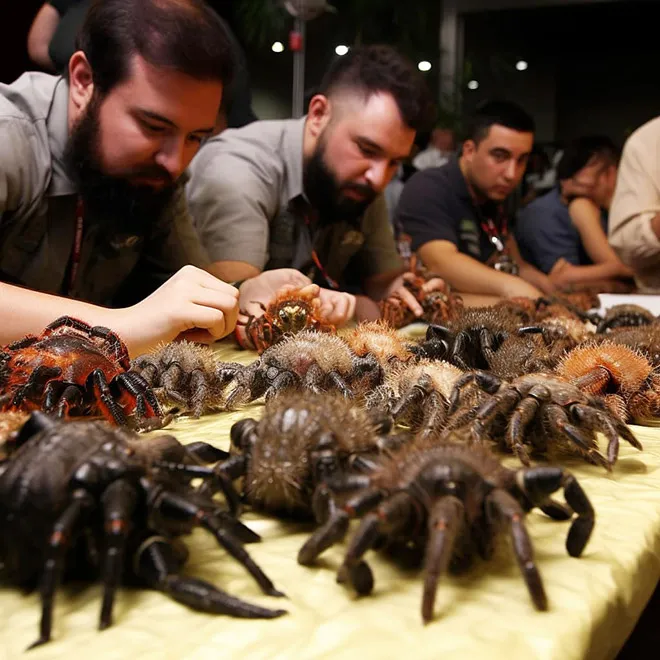What Makes Tarantula Eating Funny
The humor surrounding eating tarantulas often stems from the unexpected nature of the act. The idea of consuming a large, hairy spider is inherently shocking and can evoke immediate reactions of surprise, disgust, or amusement. This is especially true in Western cultures where insects and arachnids are generally not part of the regular diet. The element of the absurd also plays a significant role. Tarantulas, with their imposing size and appearance, are usually creatures people associate with fear or fascination, not dinner. The juxtaposition of these feelings with the act of eating creates a humorous contrast. Additionally, videos and stories of people attempting to eat tarantulas can be comedic due to the facial expressions, reactions to the texture or taste, and the overall experience. The novelty of it all contributes to the humor, as it’s a unique and uncommon activity that breaks from the everyday norm. The whole situation involves an element of risk-taking, with individuals sometimes engaging in this activity for shock value or to challenge themselves.
The Appeal of Tarantulas as Food
Despite its unconventional nature, there are several reasons why tarantulas have become a food source in certain cultures. For some, it’s a matter of survival and necessity. In regions where other protein sources are scarce, insects like tarantulas can provide essential nutrients. Tarantulas can be a sustainable and readily available source of protein. In other instances, eating tarantulas is deeply rooted in cultural traditions, with recipes and preparation methods passed down through generations. The taste and texture of tarantulas also play a role in their appeal. Many people describe the taste as being similar to crab or shrimp, with a slightly nutty flavor, particularly when cooked well. The texture can range from crispy on the outside to soft and succulent inside, depending on the cooking method. The adventurous nature of trying new foods is a factor, with people looking for unique culinary experiences. Ultimately, the appeal of tarantulas as food is a combination of cultural, economic, and gustatory factors, depending on the context.
Cultural Perspectives on Eating Tarantulas

Cultural perspectives on eating tarantulas vary widely across the globe. In some cultures, tarantulas are considered a delicacy, prepared and consumed with great care and respect. These are often cultures where insects and arachnids have long been integrated into the diet. For instance, in certain regions of Cambodia, fried tarantulas are a popular street food and are viewed as a source of both protein and income. They are often seasoned with spices and herbs, enhancing their flavor. Conversely, in many Western cultures, tarantulas are not typically consumed and are often met with disgust or apprehension. This is largely due to the cultural conditioning that associates insects and spiders with uncleanliness and aversion. The perception of tarantulas as pets or creatures to be feared also contributes to the negative sentiment. Even within Western cultures, attitudes can differ. Some people are adventurous and are open to trying exotic foods, while others may avoid anything that challenges their comfort zone. Overall, the cultural context profoundly shapes how people perceive and interact with the idea of eating tarantulas.
Countries Where Tarantulas are a Delicacy
Several countries around the world have embraced tarantulas as a culinary treat. Cambodia is perhaps the most well-known, where fried tarantulas, or ‘a-ping’, are a popular street food, particularly in the town of Skuon. The tarantulas are often flavored with salt, sugar, and chili, and they provide a crunchy exterior and a soft, meaty interior. Venezuela also has a tradition of eating tarantulas, especially in the indigenous communities of the Amazon rainforest. They are often roasted or grilled, providing a source of protein in the region. In some parts of Thailand, tarantulas are consumed, though less commonly than other insects. The preparation methods vary, but they often involve frying or grilling. The specific species of tarantula used and the preparation techniques depend on regional availability and traditional recipes. These examples highlight that tarantulas are not just a food source; they are also a cultural experience deeply rooted in tradition and resourcefulness.
The Preparation of Tarantulas
Preparing tarantulas for consumption involves several steps. The first is sourcing the tarantulas, either by catching them in the wild or, more commonly, purchasing them from suppliers. Next, the tarantulas must be cleaned and prepped. This often involves removing the fangs, which contain venom, to prevent any potential harm. The legs and the body are usually cleaned to remove any dirt or debris. Different cultures use different cooking methods and seasonings, often influenced by local preferences and available ingredients. The preparation process aims to ensure that the tarantula is safe to eat and to enhance its flavor and texture. Common preparation methods include deep-frying, grilling, or roasting, each offering a unique culinary experience. The goal is to make the tarantula palatable and enjoyable, transforming an unusual ingredient into a delicious meal. The way the tarantula is prepared is extremely important to the overall experience.
Cleaning and Preparing the Tarantula

The cleaning process for tarantulas is crucial to ensure they are safe and pleasant to eat. Begin by removing any potential hazards. The fangs, which contain venom, must be removed to eliminate the risk of a bite. The tarantula’s body is then cleaned to remove dirt, debris, and any unwanted particles. Many people choose to remove the hairs, which can cause irritation, especially in the mouth and throat, before cooking. This is often achieved by brushing them off or rubbing the tarantula’s body. Different cultures use slightly different techniques, but the goal is the same: to prepare a clean, safe ingredient for cooking. Attention to detail and thoroughness is vital to ensure a positive and safe eating experience. Proper preparation is a key part of enjoying this dish.
Cooking Methods for Tarantulas
Cooking methods for tarantulas vary based on local traditions and preferences. Deep-frying is a popular method, especially in Cambodia, where the tarantulas are fried in oil until crispy. This results in a crunchy exterior and a soft interior. Grilling is another option, often used in Venezuela, where the tarantulas are grilled over an open flame, imparting a smoky flavor. Roasting can also be used, usually in an oven, to achieve a different texture. The choice of cooking method often depends on the desired outcome and the availability of cooking equipment. Seasoning the tarantulas with herbs, spices, and sauces can significantly enhance the flavor. Each cooking method can bring out different aspects of the tarantula’s taste and texture. The chosen cooking style has a significant impact on the overall culinary experience and how the tarantula is perceived.
Deep Frying Tarantulas
Deep-frying is a commonly used method for cooking tarantulas, particularly in regions like Cambodia. The tarantulas are submerged in hot oil until they turn a deep golden-brown color. This cooking technique creates a crispy exterior and a tender interior. The oil’s heat quickly cooks the spider, and the resulting texture is often quite appealing to those accustomed to this method. The process typically involves seasoning the tarantulas before frying to enhance their flavor. This can include salt, pepper, chili, and other spices. The deep-frying process also helps eliminate any potential pathogens, ensuring the tarantulas are safe to eat. This preparation method is easy, quick, and yields a texture that many find enjoyable, which has helped it to gain popularity. Properly deep-fried tarantulas can be an attractive and flavorful food item, making it an approachable way to try this unusual dish.
Grilling Tarantulas

Grilling tarantulas is another popular method, often utilized in cultures that are used to this dish. The tarantulas are placed on a grill over an open flame, which imparts a smoky flavor. The grilling process can vary; some cooks might use skewers to keep the tarantulas in place, while others might grill them directly on the grate. During grilling, the tarantulas are often seasoned with spices, herbs, or marinades to enhance their flavor. This cooking method yields a slightly charred exterior and a tender interior. Grilling can be an effective way to cook tarantulas, imparting a unique taste that many find appetizing. The smoky flavor, combined with the seasoned tarantula, can offer a very different culinary experience, making it an appealing option for those who enjoy grilled foods. Grilling is also a relatively simple method that brings out the natural flavors of the tarantula.
Tarantula Eating Experience
The experience of eating a tarantula is often described as unique and memorable. The texture varies depending on the cooking method, but it is usually crispy on the outside and soft or meaty on the inside. The taste is often compared to crab or shrimp, with a slightly nutty flavor. The body of the tarantula, with its legs and abdomen, provides different textures and flavors. The legs are often eaten first, offering a crunchy element, while the abdomen may contain a softer, more savory texture. For first-timers, the experience is frequently one of surprise and adventure. The unexpected nature of the dish and the unfamiliar flavors make it a conversation starter. For those accustomed to eating tarantulas, it’s a matter of tradition and appreciation for the taste. The whole experience is a test of curiosity and a willingness to try something new and different, especially for those in cultures where tarantulas are not a regular part of the diet. The experience is very different depending on each individual’s past experiences and taste preferences.
First-Time Tarantula Eating Tips
For those attempting to eat tarantulas for the first time, preparation and expectations are key. Start by researching the cooking method and preparation techniques of the tarantula. Find a reputable source that uses proper cooking methods, as that has a direct impact on the overall experience. Begin with a smaller portion to gauge your reaction to the texture and flavor. It’s wise to choose tarantulas that are cooked well and are from a reliable source, as this reduces the chance of any health issues. Approach the experience with an open mind and a sense of adventure. Be prepared for a unique texture and taste, different from conventional foods. It can be helpful to consume the tarantula with others, sharing the experience and possibly making it less daunting. Most importantly, listen to your body and do not force yourself if you find the experience unpleasant. Eating tarantulas is about embracing new culinary experiences, and doing it safely will make for a better experience.
The Taste and Texture of Tarantulas

The taste and texture of a tarantula can vary depending on the cooking method, the spider’s diet, and the species. Generally, the flavor is described as a combination of slightly nutty and savory, often compared to crab or shrimp. The legs and body offer different textures. The legs tend to be crispy, providing a satisfying crunch, while the body may have a softer, more gelatinous interior. The abdomen might contain a paste-like substance, which has a distinct taste. The overall texture is a mix of crunchy, soft, and sometimes slightly chewy, depending on the preparation. The taste is influenced by any seasonings and spices used during cooking. Different preparation methods, such as deep-frying or grilling, also affect the flavor profile, adding elements of smokiness or oiliness. The taste and texture, combined with the novelty, create a unique experience for those trying tarantulas for the first time.
Potential Risks and Safety Measures
While eating tarantulas is common in some cultures, it is important to be aware of potential risks and take necessary safety measures. The primary concern is the presence of toxins or allergens. Tarantulas can carry certain toxins that might cause allergic reactions, especially if not properly prepared or cooked. To mitigate this risk, it is essential to ensure that the tarantula is sourced from a reliable supplier and that it is cooked thoroughly. Another consideration is the fangs. Although they are usually removed before cooking, small parts may remain. Always check to ensure they are removed. It’s crucial to be mindful of potential allergic reactions if you are new to tarantula eating. Start with a small portion to observe your body’s reaction. When eating tarantulas, it’s important to prioritize safety and awareness. Being cautious and knowledgeable can help to reduce the risks associated with consuming these creatures. Careful preparation and cooking are important, and so is knowing the source of the tarantula.
Allergic Reactions and Toxicity
The risk of allergic reactions and toxicity is a key consideration when eating tarantulas. Tarantulas, like any food, can trigger allergic responses in susceptible individuals. The venom, though usually removed or denatured during cooking, still poses a risk. Some people may also have allergic reactions to the proteins present in the spider’s body. Symptoms can range from mild (skin rashes) to severe (anaphylaxis). Always look for signs of allergic reactions, and have medication on hand in the event of a severe response. To avoid these risks, source tarantulas from reliable vendors. Proper cooking methods are also important. Cooking methods can eliminate or neutralize toxins. Be especially careful if you are unsure of the source or the preparation. Always check for any signs of illness or unusual symptoms after eating the tarantula, and consult with a medical professional if you experience any adverse reactions. Being aware of the potential for allergic reactions and toxicity will help promote a safe and enjoyable eating experience.
Conclusion A Unique Culinary Adventure

Eating tarantulas is a unique culinary adventure that combines the novelty of consuming an unusual food with a glimpse into different cultural traditions. While it may not be everyone’s cup of tea, the experience is a memorable one, offering insights into different cultures and a chance to expand your culinary horizons. From the cultural contexts to the preparation methods and the final taste, eating tarantulas is an exploration of adventure. For those brave enough to try, it represents a willingness to step outside their comfort zone and explore a different side of the food world. It’s a testament to the vast diversity of food traditions across the globe. Eating a tarantula isn’t just about the meal itself; it’s about the experience, the story, and the cultural connection it represents. It is a truly unforgettable experience.
